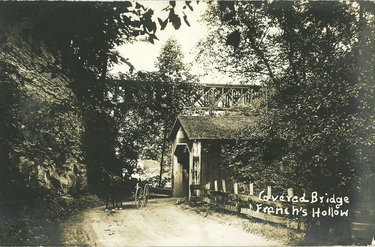Penny postcards record places of the past
When last did you write or receive a picture postcard?
Modern technology’s new communication methods have made them a thing of the past. However picture postcards of the past have proven to be a valuable resource, adding to our knowledge of long-ago scenes.
Recently, the children of the late William P. Chamberlin donated his postcard collection of local views to the Guilderland Historical Society. Included in his carefully organized and notated collection were some views never previously included in the society’s archive of photographs and postcards.
In 1873, the United States Post Office introduced postal cards printed with an image representing the one-cent postage and space to write the address on front and a blank back for the message.
Picture postcards were introduced at Chicago’s 1893 Columbian Exposition, catching on with fairgoers immediately. At first, United States postal regulations slowed their use, but by 1901 private printers were permitted to call them postcards.
However, messages were not permitted on the same side of the card as the address, resulting in only a tiny blank spot for a greeting or brief message on the picture side. Finally, in 1907, the Post Office began to permit the back to be divided for both message and address. At first, the postage was the same as a first-class letter, but later reduced to one cent.
Several factors led to the production of millions of postcards up until World War I. Kodak had developed a folding, portable camera, allowing men to visit a community or scenic spot to quickly snap prominent buildings and scenes or to travel to parklike settings, and in this area the Helderberg escarpment that became Thacher Park was the big attraction.
Two photographers who captured many views of Guilderland locations were Parker Goodfellow of Schenectady, who was supposed to have taken a total of 32,000 views as he traveled far and wide and Binghamton photographer John Dearstyne who shot some as well. Others are unidentified.
In addition to views, holiday postcards produced for Christmas, Easter, Halloween, and Valentine’s Day were popular. Other types of postcards were comic cards and cards featuring important people such as a patriotic George Washington card.
With the frequent rail service hauling attached mail cars, which delivered mail as often as twice daily, in many areas along rail lines mailing a postcard became a rapid means of communication with short messages of the “come quickly, mother is ill” or ”I will be arriving on the 4:22 train on Friday” variety.
The public not only mailed millions of postcards, they collected and mounted them in albums designed to display them. This is the reason why so many antique postcards are blank, intended only for an album.
Because postcards were inexpensive, most people could afford them. In 1911, L.S. St. John , an Altamont news dealer, advertised six new Altamont views at two for 5 cents or five for 10 cents.
Postcard “showers” for special occasions or illness were regularly mentioned in Enterprise columns. One man, having just celebrated his 80th birthday, put a card of thanks in the Enterprise to thank everyone who has sent him a total of 90 cards.
In 1913, the U.S. Post Office claimed a total of 900 million postcards had been mailed in this country.
Since huge numbers of the higher quality cards were printed in Germany, once World War I began, the supply of cards diminished, and gradually the telephone began to take the place of brief communications.
With that, the postcard lost popularity. Although postcards continued to be printed during the 20th Century, the local photo cards, especially of smaller communities, were no longer produced.
Fortunately, because so many of the old postcards were saved and have survived into the 21st Century, we are able to look at our communities as they once were.
